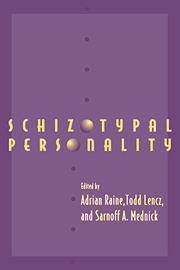Book contents
- Frontmatter
- Contents
- List of contributors
- Preface
- Acknowledgments
- Part I Introduction
- Part II Genetics and neurodevelopment
- Part III Assessment
- Part IV Categorical versus dimensional approaches
- Part V Psychophysiology and psychopharmacology
- 10 Schizotypal personality and skin conductance orienting
- 11 Attention, startle eye-blink modification, and psychosis proneness
- 12 Brain structure/function and the dopamine system in schizotypal personality disorder
- Part VI Neuropsychology
- Part VII Brain imaging
- Part VIII Conclusion
- Part IX Appendix
- Name Index
- Subject Index
12 - Brain structure/function and the dopamine system in schizotypal personality disorder
from Part V - Psychophysiology and psychopharmacology
Published online by Cambridge University Press: 04 August 2010
- Frontmatter
- Contents
- List of contributors
- Preface
- Acknowledgments
- Part I Introduction
- Part II Genetics and neurodevelopment
- Part III Assessment
- Part IV Categorical versus dimensional approaches
- Part V Psychophysiology and psychopharmacology
- 10 Schizotypal personality and skin conductance orienting
- 11 Attention, startle eye-blink modification, and psychosis proneness
- 12 Brain structure/function and the dopamine system in schizotypal personality disorder
- Part VI Neuropsychology
- Part VII Brain imaging
- Part VIII Conclusion
- Part IX Appendix
- Name Index
- Subject Index
Summary
As the increasing complexity and multifactorial interaction of pathophysiological processes in schizophrenia are more apparent, the advantages of studying the full range of schizophrenic-spectrum disorders becomes more compelling. The milder schizophrenia-related disorders, of which schizotypal personality disorder (SPD) is the prototype, offer a unique opportunity to relatively disentangle and isolate the contingent pathophysiological processes involved in the schizophrenic disorders. Furthermore, such patients are much likelier to be free of potentially confounding artifacts such as long-term neuroleptic treatment, institutionalization, or chronic psychosis. Finally, since the genetic diathesis to schizophrenia is much more likely to be manifest as SPD or even schizotypal traits than as chronic schizophrenia, the study of SPD, especially among relatives of schizophrenic patients, may lead to a better understanding of the biology and genetics of schizophrenia and point to the appropriate selection of the affected phenotype in linkage studies currently underway.
Dopamine is implicated in the pathophysiology of schizophrenia by the antipsychotic effects of neuroleptic medications as well as by studies of plasma homovanillic acid and postmortem studies. Imaging studies suggest alterations in brain structure, whereas psychophysiological and neuropsychological tests point to abnormalities in brain function.
In this chapter, current work from our laboratory investigating the biology of SPDs is presented in the context of a model of the interaction of altered brain structure/function and the dopamine system in SPD and schizophrenia.
A model of positive and negative schizotypy
Both schizophrenic and schizotypal patients evince symptoms that are related to psychosis as well as to social deficits. The psychotic symptoms of schizophrenia include hallucinations, delusions, and evidence of gross thought disorder.
Keywords
- Type
- Chapter
- Information
- Schizotypal Personality , pp. 272 - 286Publisher: Cambridge University PressPrint publication year: 1995
- 7
- Cited by



